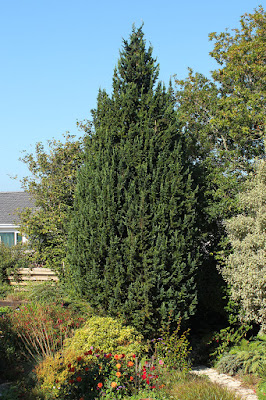A few days ago I was helping some friends with their garden. Theirs is the very common situation of people getting older and finding it increasingly difficult to cope with their quite large garden. I was struck by one thing in particular which was how evergreen shrubs and conifers had come to dominate their garden.
Everyone knows that when planning a garden, or part of a garden, it's important to try and anticipate how it's going to be in five, ten, perhaps twenty years time. I wouldn't mind betting that most peoples' thinking doesn't really go beyond the five year horizon.
In the case of a lot of plants that doesn't matter much, in that in five years most perennials and deciduous shrubs will have reached their mature size and routine maintenance will keep them there or thereabouts. By then they will have filled their allotted space leaving little or no bare ground and will be competing with each other for light and water on level terms.
However, trees, evergreen shrubs and conifers don't play by the same rules. They don't throw up new growth from the base that lasts a season or a few seasons before being pruned away. Their growth is from their extremities and it tends to be fairly constant each year for any particular species or variety. So the plants keep on getting bigger.
 |
| Some joker thought 'Little Spire' was a good name for this Lawson Cypress. At least it's quite narrow. |
Most of them are also long lived, so even after twenty years they are still full of youthful vigour. After a quarter of a century, even a "dwarf" conifer, growing only three inches a year, is now over six feet tall. Eucalyptus or "leylandii", putting on three feet a year or more, can be 75 feet monsters in the same time.
Deciduous trees can have their lower branches removed to let light in so shade loving plants can be grown beneath them. Many woodland perennials take advantage of the light available before deciduous trees have produced their full leaf canopy for the year.
With evergreens, even this opportunity is not available and the competition will lose out in the battle for light 99% of the time.
 |
| The maple and Magnolia have had their lower branches removed, creating space for shade loving plants. The camellia does not lend itself to similar treatment. |
In my friends' garden it is Rhododendrons, Camellias and conifers that have come to dominate. Large areas are in deep shade all year round. The flowers of the rhododendrons and camellias are on top of the bush, above the foliage; the lower parts of the bush mostly bare branches.
The camellias can be cut back hard and will regrow at a lower level, but regrowth is rapid and flowers will not be freely produced for a few years, by which time they may be almost the size they were before cutting. Some rhododendrons can be similarly treated, many cannot. For conifers, with the exception of Yew, it is not an option.
 |
| This Camellia has been hard pruned. It is re-growing strongly, but won't flower freely again for some years. |
So, to return to the point about crystal ball gazing when planting. If you do it for nothing else, think long and hard about how big the evergreen shrubs and conifers will be in the future. And don't make the mistake of thinking that twenty five years is so far into the future it's not worth worrying about; ask anyone over the age of sixty and they'll tell you how quickly it will flash past.
 |
| I love my Pinus parviflora 'San-Bo, but it's not going to be easy to restrict its size without spoiling its character. |












































